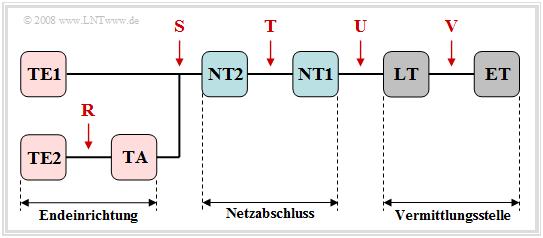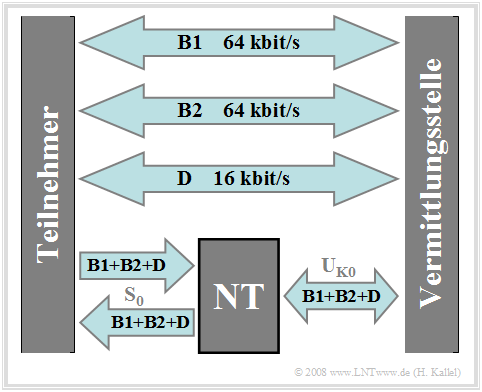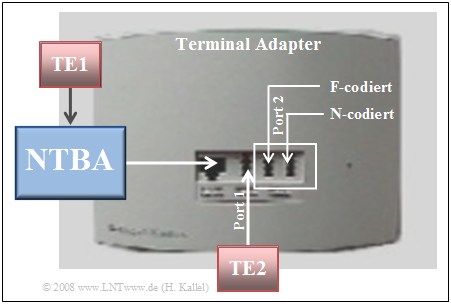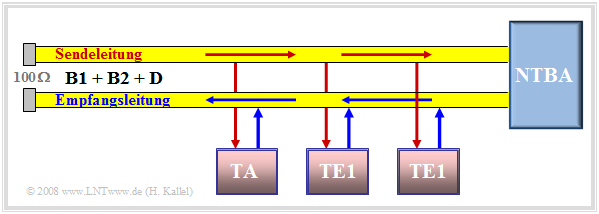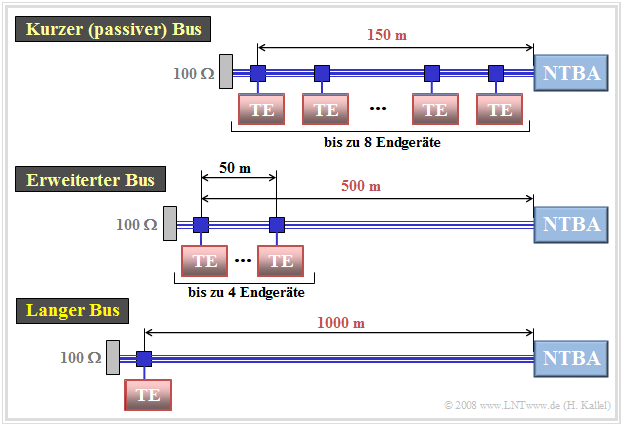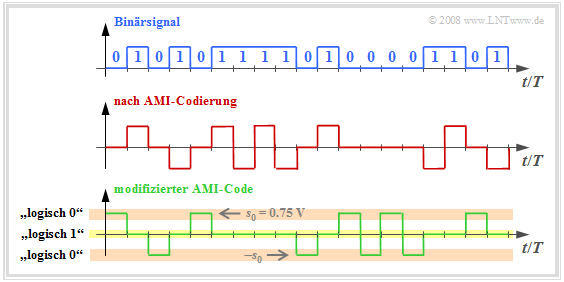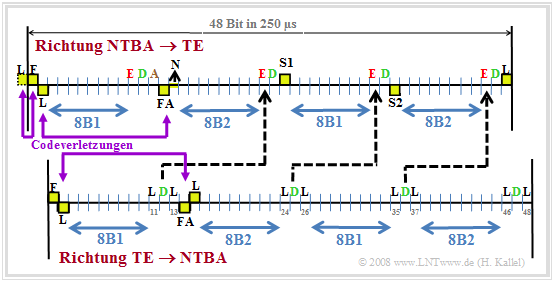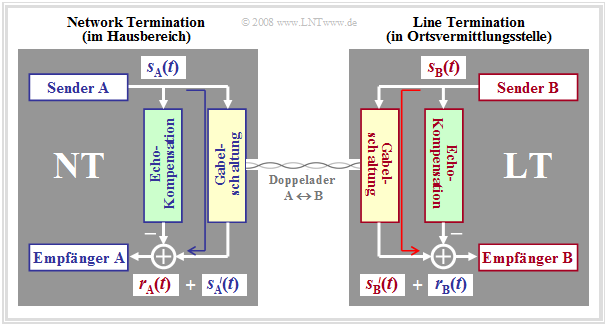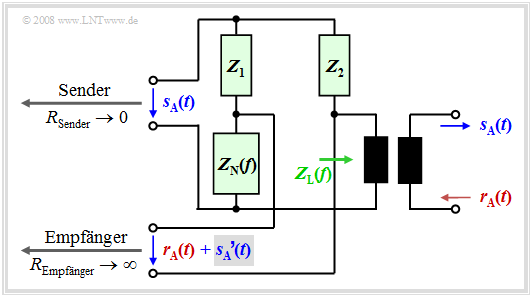Difference between revisions of "Examples of Communication Systems/ISDN Basic Access"
| Line 274: | Line 274: | ||
<br> | <br> | ||
$N\hspace{-0.05cm}$etwork $T\hspace{-0.05cm}$ermination for ISDN $B\hspace{-0.05cm}$asic Rate $A\hspace{-0.05cm}$ccess $($ $\rm NTBA)$ | $N\hspace{-0.05cm}$etwork $T\hspace{-0.05cm}$ermination for ISDN $B\hspace{-0.05cm}$asic Rate $A\hspace{-0.05cm}$ccess $($ $\rm NTBA)$ | ||
| − | *connects an in-house ISDN terminal equipment (TE) | + | *connects an in-house ISDN terminal equipment (TE) to the higher-level local network via the exchange, |
| − | * | + | *implements the conversion from the ISDN access network, which has two wires at the NTBA, to the four-wire house access line. |
| − | * | + | *is an extremely important ISDN network component, as it enables the transition between the $\rm S_0$ bus and the $\rm U_{K0}$ bus. |
| − | [[File:P_ID1506__Bei_T_1_2_S10a_v1.png|center|frame| | + | [[File:P_ID1506__Bei_T_1_2_S10a_v1.png|center|frame|Network termination device (NTBA) as a connection between $\rm S_0$ and $\rm U_{K0}$ bus]] |
Im Allgemeinen setzt sich der NTBA aus zwei Teilen zusammen, die "NT1" und "NT2" genannt werden. | Im Allgemeinen setzt sich der NTBA aus zwei Teilen zusammen, die "NT1" und "NT2" genannt werden. | ||
Revision as of 09:11, 9 October 2022
Contents
- 1 Some explanations of terms
- 2 Logical channels
- 3 Terminal equipment for ISDN
- 4 General description of the S0 interface
- 5 Message-related aspects of the S0 interface
- 6 Frame structure of the S0 interface
- 7 Collision-free access to the D channel
- 8 General description of the UK0 interface
- 9 Telecommunications aspects of the UK0 interface
- 10 Frame structure of the UK0 interface
- 11 Network termination (NTBA)
- 12 Directional separation method
- 13 Hierarchie von Vermittlungsstellen
- 14 Aufgaben zum Kapitel
Some explanations of terms
The most common type of ISDN connection is the so-called basic rate interface (BRI), which is used in particular by residential customers and medium-sized companies.
As shown in the diagram, an ISDN connection consists of the following functional groups:
- Terminal Equipment Type 1 (TE1, ISDN terminal equipment),
- Terminal Equipment Type 2 (TE2, analog terminal equipment),
- Terminal Adapter (TA),
- Network Termination 1 (NT1),
- Network Termination 2 (NT2, optional),
- Line Termination (LT),
- Exchange Termination (ET).
The reference points between the individual function groups are designated $\rm R$, $\rm S$, $\rm T$, $\rm U$ and $\rm V$. This also results in the usual ISDN designations of various buses:
- $\rm S_{\rm 0}$ bus: Reference point $\rm S$ between subscriber line area and network termination; the $\rm 0$ stands for basic rate interface.
- $\rm U_{\rm K0}$ bus: Reference point $\rm U$ between network termination and local exchange; the $\rm K$ stands for copper cable, the $\rm 0$ again for
basic rate interface.
The following sections describe this subscriber line configuration and the interfaces of the ISDN basic rate interface in detail.
Logical channels
The basic rate interface consists of at least three channels, namely two user channels (B channels) with 64 kbit/s each and one signaling channel (D channel) with 16 kbit/s.
- A $\rm B$ channel ( Bearer Channel) is used for the transmission of user information (voice, texts, images, data, etc.). Two B channels can be active at the same time, operate independently of each other and have different destination devices.
- The $\rm D$ channel ( Data Channel) is mainly responsible for controlling the B channels. In particular, it is responsible for establishing and terminating connections and for communication control.
- In addition, the D channel can be used for data transmission. Due to the low data rate (16 kbit/s), however, this is only of interest for applications with very low data volumes, for example, monitoring systems or online booking systems.
The graphic shows the logical channels of the ISDN basic rate interface. The subscriber has
- with the two basic channels (64 kbit/s each) and
- the combined data and signaling channel (16 kbit/s)
a total net bandwidth of 144 kbit/s at his disposal.
All logical channels are bidirectional. The lower part of the graphic shows the implementation in the basic rate interface:
- Between the exchange and the network termination – i.e. on the $\rm U_{\rm K0}$ bus – there is a two-wire connection that is operated in both directions.
- In contrast, four-wire transmission is used in the house connection area – on the $\rm S_{\rm 0}$ bus – whereby one twisted pair is required for each of the two directions.
Terminal equipment for ISDN
There are two different types of terminal equipment for ISDN:
- Terminal Equipment Type 1 (TE1): This includes, for example, ISDN-capable telephones, ISDN group 4 fax devices and ISDN PC cards. These terminal equipments are connected directly to the $\rm S_{\rm 0}$ interface via the network termination (Network Termination for ISDN Basic rate Access, NTBA).
- Terminal Equipment Type 2 (TE2): This refers to terminal equipment for the analog telephone network (telephones, group 3 fax machines and conventional modems) that must be connected to the $\rm S_{\rm 0}$ interface via a terminal adapter.
- Terminal Adapter (TA): This allows TE2 devices to be used with ISDN. Such adapters can have analog interfaces to the terminal (so-called a/b interfaces) or digital interfaces, for example for connecting terminals via V.24 or X21.
$\text{Example 1:}$ The graphic shows a possible ISDN configuration.
In the center is the terminal adapter "TA2a/b Komfort" from Deutsche Telekom, which is part of the uni@home package. This has two integrated a/b ports with three TAE sockets for analog terminals:
- Port 1 is universal coded; one really speaks of "encoding" here, even if this pin assignment has nothing to do with an encoding in the message-technical sense. TE2 terminals of any kind (telephone, fax, modem, etc.) can be connected to this port.
- Port 2 consists of an N-encoded (the "N" stands for non-voice devices)
TAE socket such as fax, answering machine, etc. and an F-encoded socket for a telephone. For port 2, only one of the two inputs can be active at a time.
General description of the S0 interface
The $\rm S_{\rm 0}$ bus is an in-house bus and represents the connection between the network termination adapter (NTBA or NT) and the ISDN terminal equipment (TE). Up to eight terminal devices such as telephones, fax machines, ISDN cards and also ISDN private branch exchanges can be connected simultaneously to a maximum of twelve connection sockets.
Such an ISDN multiple subscriber line has:
- three Multiple Subscriber Number (MSN) – expandable up to ten,
- two user channels (B channels) with 64 kbit/s each for the various services,
- one signaling or data channel with 16 kbit/s,
- twelve connection sockets with up to eight connected devices (but only four voice terminals).
From the graphic you can see:
- Of a four-core copper cable, two cores (one twisted pair) are used to transport data from the terminal equipment (TE) to the NTBA (transmission line) and the other twisted pair is used to transfer data from the NTBA to the TE (reception line).
- Please note that in some technical articles the direction "TE → NTBA" is referred to as the reception line and the opposite direction "NTBA → TE" as the transmission line. This different description compared to our tutorial results from the view of the NTBA.
- The $\rm S_{\rm 0}$ bus provides two B channels (B1 and B2) for user data transmission with 64 kbit/s each and additionally the D channel with 16 kbit/s for signaling during connection setup and for various synchronization data.
- This results in a net transmission rate of $\text{144 kbit/s}$ per direction for the $\rm S_{\rm 0}$ bus. The gross transmission rate, taking control bits into account, is $\text{192 kbit/s}$.
Several terminals can be connected in parallel to the network termination (Network Termination for ISDN Basic Rate Access, NTBA) via the $\rm S_{\rm 0}$ bus.
Please note the following:
- The open line ends must be terminated with the wave impedance of 100 Ω (real), otherwise reflections will occur.
- The $\rm S_{\rm 0}$ bus generally reacts tolerantly to mismatching, but in this case certain length limitations and installation rules must be observed.
- The possible cabling types for the $\rm S_{\rm 0}$ bus in the multi-device connection operating mode are shown in the graphic below.
The usual connection type is the short passive bus with a maximum length of 150 meters. Up to eight terminal equipment – distributed as required – can be connected to this bus. We will not use the term "passive" in the following, nor for the other connection types.
The extended bus is at least 100 meters and at most 500 meters long. A maximum of four terminal equipment can be connected, but these may only be positioned within the last 50 meters before the terminating impedance.
For a point-to-point connection, the cable length can be up to 1000 meters. In this case, it is referred to as a long bus. It should be noted, however, that only one terminal equipment can be connected at this length ("single connection").
On the $\rm S_0$ bus, the two B channels and the D channel are transmitted together with synchronization and control bits in frames of 48 bits each in time division multiplex. The modified AMI code (the name stands for Alternate Mark Inversion ) is used, which can be characterized as follows:
- The logical (binary) "1" is represented by the voltage value $0\ \rm V$ and the logical (binary) "0" alternately by $+s_0$ or $-s_0$, as the comparison of the upper and lower signal waveforms in the graphic of $\text{Example 2}$ shows. For ISDN, the modulation range $s_0 = 0.75\ \rm V$ is fixed.
- The pseudo ternary coding ensures that the $\rm S_0$ bus remains free of DC voltage at all times. The redundancy of $1 - 1/\log_2 (3) ≈ 37\%$ is used in ISDN, for example, for frame synchronization by deliberately violating the AMI coding rules to mark frames.
- The $\rm S_0$ bus is writable by the logical AND operation. This means that the NTBA only receives the logical "1" if all terminal devices send a logical "1" - i.e. the zero level. If only one device sends the logical "0", this is also received.
- All terminal equipment obtains its clock from the NTBA and operates bitsynchronously. The quiescent signal is always the zero level, i.e. the logical "continuous one". In addition, since all devices in the D channel always transmit a "0" with the same polarity, pulses cannot cancel each other out.
$\text{Example 2:}$ The graphic illustrates the difference between modified and "conventional AMI code", namely the swapping of "0" and "1" in the binary signal. The reason for this interchange is:
- With the normal AMI code, no symbols are transmitted during a speech pause either, or in other words, only pulses with the amplitude $0 \ \rm V$ are transmitted over a longer period of time (see middle diagram). This makes clock synchronization more difficult.
- With the modified AMI code (lower diagram), positive and negative pulses alternate ⇒ simple clock synchronization at "duration zero". Critical now is a "continuous one" signal, but this never (or only extremely rarely) occurs in voice transmission.
We received this note on the practical significance of the modified AMI code from Prof. Peter Richert (FH Münster). Many thanks!
Frame structure of the S0 interface
The frame structure of the $\rm S_0$ interface - i.e. the bus between the network termination (NTBA) and the subscriber terminal equipment (TE) - is shown in the upper part of the following graphic. The lower part shows the frame structure in the opposite direction (TE → NTBA).
Each frame consists of
- je 2 · 8 = 16 bits for each of the two B channels (32 bits in total),
- 4 bits for the D channel (marked green) and
- another 12 control bits, which are different for the two transmission directions.
Each frame is thus composed of 48 bits, which are transmitted in 250 microseconds (4000 frames per second).
This results in a total gross bit rate of 48 · 4000 = 192 kbit/s.
The twelve bits for control information are composed as follows:
- A bit: activation bit (marked in brown),
- E bits: bits for echo channel (marked red),
- F bit: frame synchronization bit,
- FA bit: additional frame synchronization bit,
- L bits: DC equalization bits,
- N bit: inverted FA bit,
- S bits: reserved for future applications.
The interaction of these control bits is described in $\text{Example 3}$. First of all, only this much:
- Each frame is composed of subframes, whereby each subframe – and thus the entire frame - must be kept DC-free. To achieve this, so-called "L bits" are used in each subframe.
- Such L bit is always logical "0" with positive or negative polarity $(±0.75 \ \rm V)$, if the number of polarity changes after the last L bit is odd. On the other hand, if the number of polarity changes is even, the L bit is logic "1" ⇒ $0 \ \rm V$.
$\text{Example 3:}$ The following description of the bit assignment (depending on the transmission direction) is based on the above graphic for the $\rm S_0$ frame structure.
In both directions:
- The first bit of each frame is the frame synchronization bit $($F bit$)$. This is always "0" with positive polarity ⇒ $+0.75 \ \rm V$.
- This is followed by a DC compensation bit $($L bit: "0" with negative polarity ⇒ $-0.75 \ \rm V)$ to prevent a DC component.
- Since an L bit $($with level $+0.75 \ \rm V)$ has also occurred at the end of the last frame, the F bit of the current frame leads to a deliberate violation of the AMI coding rule (purple marking in the graphic), which is used for frame synchronization.
- The 14th bit is an additional frame synchronization bit $($FA bit$)$ which is always set to "0 negative" $(-0.75 \ \rm V)$.
- Since the subframe between bits 3 and 13 is always DC-free, the FA bit (#14) also generates an intentional code violation together with the L bit (#2).
- This second code violation confirms the code violation originating from the F bit. This prevents a transmission error from being incorrectly interpreted as a frame start.
- Loss of frame synchronization is assumed when no code violation pairs are identified within two frames.
- Frame synchronization is complete when three consecutive code violations have been detected: F – FA – F.
Different terminal equipment can transmit simultaneously in the transmitting direction (lower graphic):
- Each device must be DC-free by the respective L bit after each B channel (bit 11, 24, 35, 46) and D channel (bit 13, 26, 37, 48).
- The L bit at position 15 is always "0" with positive polarity $(+0.75 \ \rm V)$.
In the reception direction (upper graphic), only the NTBA transmits and thus a single compensation bit $($L bit$)$ is sufficient except for bit 2 at the end.
In addition, there are further control bits in this direction (NTBA → TE):
- The thirteenth bit is the activation bit $($A bit$)$. This is set to "0" when activated and to "1" when deactivated.
- The N bit at bit position 15 always directly follows the FA bit and is inverted with respect to it, i.e. set to "1" ⇒ $0 \ \rm V$.
- Thee S bits S1 and S2 are reserved for future applications and are currently always set to logical "0" (with different polarity).
- The total of four E bits (bits for the echo channel) in the reception direction depend on the D bits of the transmission direction.
These bits can be used to decide which terminals are currently allowed to transmit. This will be discussed in detail in the next section.
Collision-free access to the D channel
Finally, it will be shown how ISDN allows several terminals to access the D channel without collisions, and which terminal has priority when transmitting. The $\rm C$arrier $\rm S$ense $\rm M$ultiple $\rm A$ccess (CSMA) method is used for blocking and unblocking the D channel and can be described briefly as follows:
- The echo channel is inserted into the data stream for the direction NTBA → TE. This is the totality of the "E bits" marked in red in the graphic (on the previous page), each of which transmits a previously received D bit back to the terminals.
- An E bit results from the UND operation of all participants. This means: In the echo channel, the logical "1" only occurs if every participant reports a "1" - i.e. sends nothing. A "0" in the echo channel indicates that a device has access to the D channel or at least wishes to do so.
- Each terminal equipment checks whether the D channel is free or busy by listening on the echo channel. For this purpose, the terminal waits for at least $N$ consecutive logical ones $(0 \ \rm V)$ in the echo channel. For a telephone device $N = 8$, for data devices $N = 10$.
- After $N$ ones, one can assume with sufficient certainty that there is a free D channel and the device starts to transmit. For transmission security, each piece of user information starts and ends with the bit pattern "01111110" (flag) according to the protocol of layer 2 of the OSI reference model.
$\text{Example 4}$ shows which terminal equipment is given priority when two terminal equipment want to start transmitting at the same time.
$\text{Example 4:}$ Two terminal equipment TE1 and TE2 want to access the D channel at the same time. They both wait for $N = 8$ consecutive logical ones on the echo channel $($marked blue in the graphic, time marker $t_1)$.
- After that, both send - again simultaneously - a flag $($green mark, time marker $t_2)$.
- At time $t_3$, both terminals now send their actual information. In the echo channel, a collision is only detected if the bits of TE1 and TE2 differ.
- The logical "0" has priority over the logical "1". In the example TE2 has priority over TE1, because the fifth bit of TE2 is a "0" and the fifth bit of TE1 is a "1" (red marks).
- Thus TE1 will stop the transmission. It can only send its information at time $t_7$ after TE2 completes its transmission with a flag $(t_4)$, and thus the D channel is free again from $t_5$.
- TE1 checks this during time marker $t_5$ and sends a flag again afterwards $(t_6)$.
General description of the UK0 interface
According to the "ISO-OSI reference model", the $\rm U$ interface is generally the connection between the network termination (Network Termination for ISDN Basic rate Access, NTBA) and the line termination (LT) in the exchange.
- In the case of the ISDN basic rate interface, this point is called the die $\rm U_{K0}$ interface and the associated bus the $\rm U_{K0}$ bus. $\rm K$ stands here for the transmission medium "copper" and $0$ for the basic rate interface.
- The line termination (LT) forms the transmission-technical termination on the network side. It handles all switching and operational tasks, line coding, transmission control, remote power supply, and test and monitoring functions.
The graphic shows the $\rm U_{K0}$ interface as the network access for a subscriber. This interface (or the associated bus) is characterized by the following features:
- The $\rm U_{K0}$ bus is implemented by two-wire transmission over a single copper twin wire, with ranges of 8 kilometers (with 0.6 millimeter diameter) or 6 km (with 0.4 mm diameter) possible.
- The gross data transmission rate is 160 kbit/s in both directions, distributed over two B user channels of 64 kbit/s each, the D channel with 16 kbit/s and an additional 16kbit/s channel for synchronization and service.
- In contrast to the $\rm S_0$ bus (modified AMI code), a transmission code with less redundancy is used here. In Germany and Belgium, a 4B3T code is used (see next section), in other European countries the redundancy-free quaternary code (2B1Q).
- In the 2B1Q code, two binary symbols are mapped to one quaternary symbol each; the four possible voltage values are $±2.5 \ \rm V$ and $±0.83 \ \rm V$. The advantage is the smaller symbol rate (step rate) of 80000 quaternary symbols per second (80 kBaud) and thus a larger range.
- The disadvantage is that transmission errors cannot be detected due to the lack of redundancy and that the 2B1Q code is not equal-signal-free.
Telecommunications aspects of the UK0 interface
In the ISDN network of Deutsche Telekom - as in Belgium - the MMS43 code $(\rm M$odified $\rm M$onitored $\rm S$um $4$B$3$T$)$ is used for transmission on the $\rm U_{K0}$ bus. This pseudoternary code has already been discussed in "Exercise 2.6" of the book "Digital Signal Transmission". For more information, refer to the chapter "Block Coding with 4B3T Codes" of the same book. The graphic shows the four code tables of the MMS43 code.
In the following, only the most important properties will be summarized:
- In each 4B3T code, four binary symbols $\rm (4B)$ are represented by three ternary symbols $\rm (3T)$, which are simplified here as "-", "0" and "+". These symbols represent the signal levels $–2.5 \ \rm V$, $0 \ \rm V$ and $+2.5\ \rm V$. The ternary decision has two thresholds.
- Compared to the binary code – and also compared to the AMI code - the step rate (symbol rate) is $25\%$ smaller. This means: The bit rate $160 \ \rm kbit/s$ leads here to the symbol rate $120 \ \rm kBaud$ $(120 \hspace{0.08cm}000$ ternary symbols per second$)$ and not to $160 \ \rm kBaud$ as on the $\rm S_0$ bus.
- The symbol rate is larger than for the 2B1Q code $(80 \ \rm kBaud)$. However, a significant advantage of the redundant 4B3T code is that it is free of equal signals. This means that a constant voltage value of $+2.5\ \rm V$ or $-2.5\ \rm V$ cannot occur over a longer period of time.
- Another characteristic of the MMS43 code is that four different code tables are available for the conversion from binary to ternary, which are selected according to the running digital sum ${\it Σ}_l$ (of the ternary values). The graph shows these tables.
- Six of the total $16$ entries (marked by red arrows) are the same in all four lines and thus apply independently of the running digital sum (RDS). These ternary sequences each contain a "+" and a "-" so that the RDS value is preserved: ${\it Σ}_{l+1} = {\it Σ}_l$.
- Let us now consider a binary word with different entries: If ${\it Σ}_l= 0$, the binary sequence "0000" is replaced by "+ 0 +", increasing $\rm RDS$ by $2$. In all other cases, "0 - 0" is output, decreasing $\rm RDS$ by $1$.
- The two lines of the table for ${\it Σ}_l= 1$ and ${\it Σ}_l= 2$ differ only in two entries, which are highlighted in the graphic by blue frames. This is the only difference between the MMS43 code and the conventional MS43 code, which makes do with only three code tables.
Frame structure of the UK0 interface
Each frame on the $\rm U_{K0}$ bus is made up of $120$ ternary symbols and is transmitted in one millisecond. This results in a symbol rate (step rate) of $120 \ \rm kBaud$.
The graphic illustrates the $\rm U_{K0}$ frame structure,
- in the upper part in the direction from the network termination (NTBA) to the line termination (LT) in the local exchange,
- below in the opposite direction, from the LT to the NTBA.
It can be seen:
- The information symbols are embedded in four subframes $\rm T1$, ... , $\rm T4$ of 27 ternary symbols each, which result from 36 input bits according to the 4B3T coding.
- These 36 bits are composed of 16 bits each of the two B channels $\rm B1$ and $\rm B2$ and four bits of the $\rm D$ channel, which are interleaved.
- Furthermore, there is a synchronization word $(\rm Sync)$ derived from the Barker code with eleven ternary symbols that differ in position and content for the two directions.
- The maintenance symbol $\rm M$ (red marking) is derived from eight overframes and is mainly used for service purposes.
Network termination (NTBA)
$N\hspace{-0.05cm}$etwork $T\hspace{-0.05cm}$ermination for ISDN $B\hspace{-0.05cm}$asic Rate $A\hspace{-0.05cm}$ccess $($ $\rm NTBA)$
- connects an in-house ISDN terminal equipment (TE) to the higher-level local network via the exchange,
- implements the conversion from the ISDN access network, which has two wires at the NTBA, to the four-wire house access line.
- is an extremely important ISDN network component, as it enables the transition between the $\rm S_0$ bus and the $\rm U_{K0}$ bus.
Im Allgemeinen setzt sich der NTBA aus zwei Teilen zusammen, die "NT1" und "NT2" genannt werden.
Die Aufgaben des obligatorischen Abschlusses NT1 sind:
- die Umsetzung von Zweidraht– auf Vierdrahtleitung (und umgekehrt) sowie die Codeumsetzung zwischen 4B3T–Code $(\rm U_{K0})$ und AMI–Code $(\rm S_0)$,
- die Stromversorgung für den $(\rm S_0)$–Bus $(230\ \rm V$, maximal $4.5\ \rm W$ Leistungsabgabe$)$, wobei der NT1 im Normalbetrieb von der Vermittlungsstelle über die $\rm U_{K0}$–Schnittstelle gespeist wird,
- die Stromversorgung von bis zu vier Endgeräten der $\rm S_0$–Schnittstelle im Notbetrieb; hierzu muss der NT1 an eine sichere Stromversorgung angeschlossen werden,
- die Ausführung aller Betriebsfunktionen; hierzu gehören u. a. das Erkennen von Rahmenfehlern und die Durchführung von Tests und so genannten Schleifenbildungen.
Der optionale NT2 wird nur gebraucht, wenn hinter dem Netzabschluss eine Nebenstellenanlage angeschlossen werden soll:
- Im Netz der Deutschen Telekom lassen sich aber bis zu acht Endgeräte (maximal vier ISDN–Telefone) über den passiven $\rm S_0$–Bus anschließen.
- In diesem Fall kann auf den NT2 auch bei Nebenstellenkonfiguration verzichtet werden. Der NTBA besteht dann nur aus dem NT1.
Directional separation method
Wegen seiner Übertragungseigenschaften (große Übertragungsreichweite, geringe Bandbreite) wird auf dem $\rm U_{K0}$–Bus das so genannte Vollduplex–Frequenzgleichlageverfahren angewandt, das heißt, dass die Signale in Sende– und Empfangsrichtung über eine Zweidrahtleitung zur gleichen Zeit und im gleichen Frequenzband übertragen werden.
Die Signale der Sende– und Empfangsrichtung werden mit Hilfe einer Gabelschaltung voneinander getrennt, wie in der Grafik dargestellt ist. Die Realisierung wird im $\text{Beispiel 5}$ ausführlich erklärt. Hier nur eine kurze Erläuterung der Arbeitsweise am Beispiel von Teilnehmer $\rm A$:
- Beim Empfänger $\rm A$ sollte nur das Signal $r_{\text{A}}(t)$ ankommen, das ohne Störungen, Verzerrungen und Echos gleich dem Sendesignal $s_{\text{B}}(t)$ von Teilnehmer $\rm B$ wäre (rot eingezeichnete Komponente).
- Dem Signal $r_{\text{A}}(t)$ überlagert sich aber nun das Signal $s_{\text{A}}\hspace{-0.03cm}'(t)$, das über die Gabelschaltung vom eigenen Sender an den Empfänger gelangt. Dies ist durch den blauen Pfeil angedeutet.
- Aufgabe der Gabelschaltung ist es nun, diesen Anteil $s_{\text{A}}\hspace{-0.03cm}'(t)$ des Empfangssignals möglichst gering zu halten. Dies gelingt bei schmalbandigem Sendesignal – zum Beispiel Sprache – im Allgemeinen sehr gut, nicht jedoch für ein Breitbandsignal.
In diesem Fall muss zusätzlich das Echokompensationsverfahren angewandt werden (siehe grün hinterlegte Blöcke in obiger Grafik). Dessen Funktionsweise lässt sich in aller Kürze wie folgt darstellen:
- Der Sender gibt regelmäßig Testsignale ab und misst das jeweils ankommende Signal, das zum einen über die Gabelschaltung vom Teilnehmer $\rm B$ herrührt, zum anderen aber auch durch Nahnebensprechen an den eigenen Empfänger gelangt.
- Aus der ermittelten Echo–Impulsantwort berechnet der Echokompensator das erwartete Echo im Normalbetrieb des eigenen Senders und subtrahiert dieses vom Empfangssignal.
- Der Echokompensator lässt sich zum Beispiel durch ein Transversalfilter realisieren, dessen Filterkoeffizienten von einem Prozessor eingestellt und nachgeregelt werden.
$\text{Beispiel 5:}$ Die Grafik zeigt eine gängige Realisierung der Gabelschaltung. Man erkennt
- links die Sende– und Empfangsleitung der $\rm S_0$–Schnittstelle, und
- rechts den Zweidrahtanschluss der bidirektionalen $\rm U_{K0}$–Schnittstelle.
Die Aufgabe der Gabelschaltung ist es,
- das (blaue) Sendesignal $s_{\text{A} }(t)$ von der $\rm S_0$– auf die $\rm U_{K0}$–Seite durchzuschalten, und
- das (rote) Empfangssignal $r_{\text{A} }(t)$ in die Gegenrichtung.
Dabei ist darauf zu achten, dass der $\rm S_0$–Empfänger möglichst vollständig vom $\rm S_0$–Sender entkoppelt ist. Das heißt:
- Der grau hinterlegte Signalanteil $s_{\text{A} }\hspace{-0.03cm}'(t)$ auf der Empfangsleitung sollte verschwinden oder zumindest sehr klein sein.
Diese Schaltung funktioniert in folgender Weise:
- $Z_{\rm L}(f)$ ist der Eingangswiderstand der über den Übertrager angekoppelten Kupferleitung des ISDN–Zugangsnetzes und $Z_{\rm N}(f)$ die künstliche Leitungsnachbildung in der Gabelschaltung.
- Gilt $Z_1/Z_{\rm N}(f) = Z_2/Z_{\rm L}(f)$, so ist $s_{\text{A} }\hspace{-0.03cm}'(t) = 0$. Hierbei bezeichnen $Z_1$ und $Z_2$ reelle Widerstände. $Z_{\rm L}(f)$ und $Z_{\rm N}(f)$ sind komplex und damit frequenzabhängig.
- Bei Schmalbandsignalen gelingt die Nachbildung von $Z_{\rm L}(f)$ durch $Z_{\rm N}(f)$ relativ gut, so dass $s_{\text{A} }\hspace{-0.03cm}'(t)$ bereits durch die Gabelschaltung hinreichend klein gemacht werden kann. Dagegen ist dies bei breitbandigen Signalen nicht für den gesamten Frequenzbereich möglich. Hier muss zusätzlich die auf der letzten Seite beschriebene Echokompensation angewandt werden.
Hierarchie von Vermittlungsstellen
$\text{Vorbemerkungen:}$
- Die folgenden Angaben haben früher so gegolten. Heute (2017) gelten sie sicher nicht mehr ganz, da ISDN auch in Deutschland keine große Zukunft mehr haben wird – in anderen Ländern hatte es nie diese Bedeutung.
- Die Deutsche Telekom hat schon vor längerer Zeit angekündigt, dass ISDN 2018 abgeschaltet und durch das Next Generation Network $\rm (NGN)$ mit paketvermittelter Netzinfrastruktur ersetzt wird. Spätestens 2022 wird Vodafone diesem Beispiel folgen. Wir belassen es trotzdem bei diesem (inzwischen eher historischen) Kapitel, benutzen aber hier die Vergangenheitsform.
Eine Vermittlungsstelle (englisch: Exchange) stellte die Vermittlungstechnik für das Fernsprechnetz und für den logischen und physikalischen Verbindungsprozess zwischen den Teilnehmeranschlussleitungen her.
Im Fernsprechnetz der Deutschen Telekom hat man bis vor wenigen Jahren zwischen mehreren Hierarchiestufen unterschieden:
- Die Ortsvermittlungsstellen (OVSt) bildeten die unterste Ebene. Eine OVSt – später DIVO (Digitale Vermittlungsstelle Ort ) genannt – verwaltete bis zu 100 000 Teilnehmer und erfüllte alle vermittlungstechnischen Funktionen innerhalb eines Ortsnetzes und den Einstieg in das Fernnetz.
- Darüber lagen so genannte Knotenvermittlungsstellen (KVSt), die untereinander vermascht und mit verschiedenen Hauptvermittlungsstellen verbunden waren. Im Gebiet der Deutschen Telekom gab es ca. 620 Knotenvermittlungsstellen.
- Die nächste Hierarchiestufe bildeten die Hauptvermittlungsstellen (HVSt), von denen es in der Bundesrepublik Deutschland etwa 50 gab. Auch diese waren untereinander und mit der darüber liegenden Hierarchieebene (ZVSt) verbunden.
- Die Zentralvermittlungsstellen (ZVSt) ergaben die oberste Hierarchiestufe des Fernnetzes und versorgten große regionale Gebiete, zum Beispiel die Rufnummern "02..." in Nordrhein–Westfalen oder "07..." in Baden–Württemberg.
- Jede ZVSt war zudem auch mit einer Auslandsvermittlungstelle (DIVA, Digitale Vermittlungsstelle Ausland) verbunden.
Die Grafik fasst diesen hierarchischen Aufbau zusammen. Hierbei sind die Aufgaben der KVSt, HVST und ZVSt zur Fernvermittlungsstelle (DIVF, Digitale Vermittlungsstelle Fern) zusammengefasst. Bei größeren Städten war eine etwas veränderte Strukturierung gegeben.
- Eine Ortsvermittlungsstelle (OVSt) realisiert den Referenzpunkt $\rm V$ des ISDN–Netzes.
- Sie wird zum Teilnehmer hin (Ende der $\rm U_{K0}$–Schnittstelle) durch den Leitungsabschluss (LT: Line Termination) einer Kupfer–Doppelader begrenzt.
- Die zweite Begrenzung ist der Vermittlungsabschluss (ET: Exchange Termination) zum darüberliegenden Fernnetz.
Aufgaben zum Kapitel
Aufgabe 1.3: ISDN–Rahmenstruktur
Aufgabe 1.3Z: Bussystem und Schnittstellen von ISDN
Aufgabe 1.4: AMI– und MMS43–Code
Aufgabe 1.4Z: Modifizierter MS43–Code
